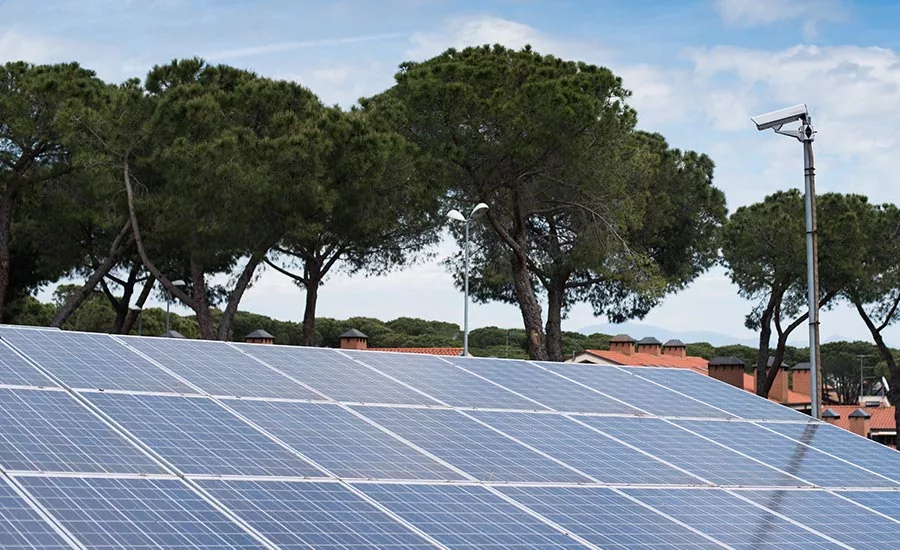Learning from the U.S. Military: How Solar-Powered Microgrids Can Improve Your Company’s Security

Similar to the U.S. military, modern companies would be crippled without power from the electric grid. This aging critical infrastructure is highly vulnerable to three types of external threats:
- Natural disasters, which cause $18 billion to $33 billion every year from power outages and damages to U.S. infrastructure;
- Intentional physical attacks from terrorism, bombing or sabotage; and
- Cyberattacks, where the U.S. Department of Homeland Security reports nearly half of “cyber incidents” targeting critical infrastructure sectors aim at the electric grid.
Most military bases have backup generators, very similar to the systems in place in businesses with critical needs for electricity. Generally there is enough fuel on site to provide power if the grid fails for a short time. A new study shows how solar-powered microgrids deployed at all U.S. military bases could significantly reduce these types of threats for the long term.
Why Worry About Long-term Power Outages?
Power disruptions have historically been quickly fixed by the electric utilities, however, they cannot currently defend against any form of systematic attack. Consider for example, that a 2013 “sniper attack” on California's PG&E substation disabled 17 transformers supplying power to Silicon Valley with about 100 rounds from a gun available at Wal-Mart. The assault only lasted 19 minutes, not even enough time to watch a whole episode of Keri Russell’s antics in The Americans. Thousands of gallons of oil leaked, which overheated the electronics and forced them to shut down. PG&E engineers managed to keep the electricity on in Silicon Valley by routing power from other sources, but repairs and improvements cost roughly $100 million and lasted 27 days. What would have happened if the terrorist had attacked for a full hour or targeted many substations around Silicon Valley systematically? Engineers at electric utilities have no way to stop that kind of assault today.
Or consider that according to senior intelligence officials, various nation states (e.g. China, Russia, North Korea) have attempted to map the U.S. electrical system. As an example of what would happen if this information were used consider how Ukraine's grid was recently disrupted by cyberattacks. The U.S. Department of Energy has urgently requested new powers to defend us from such attacks while warning that our electric grid is extremely vulnerable and attacks are only a matter of time.
Resultant damages could be long lasting, as power plants operate with large transformers that are difficult to move, source and replace (i.e. months or even years). The grid is remarkably insecure in the face of such an attack, and thus so is your business. Storing enough diesel fuel for a long-term outage is both economically prohibitive as well as unsafe, as it provides another target.
Securing Your Business with Solar-Powered Microgrids
Fortunately, the technical community offers a direct solution to these threats: distributed generation and microgrids. Distributed generation refers to making the power where you use it and microgrids allow the generation system to separate from distribution during power outages. To ensure that a microgrid is operational during a blackout without reliance on a fuel source (as fuel supply lines can be disrupted too), some form of predicable renewable energy resource is recommended for the primary power source. Solar photovoltaic systems, which generate electricity directly from sunlight, are an ideal distributed generation technology to provide power for such microgrids as the sun shines most everywhere.
The Department of Defense is well aware it is vulnerable to an attack on the civilian electrical infrastructure and has made attempts to protect itself. Title 10 USC 2911 requires military operations to obtain 25 percent of energy generation from renewable energy resources by 2025 and 3GW of capacity minimum. Although this is technically “greening the military,” this decision was strategic not environmental. The military has already begun to experiment with solar-powered microgrids such as the system at Fort Bliss. Unless you work for one of the few companies that have already begun to invest in their own solar-powered microgrids, you are exposed.
Fortunately, research and development on such microgrids is well advanced, and no new technology is needed. The systems are technologically feasible. Even better, because of the radical reduction in costs for solar photovoltaic systems the levelized cost of electricity can be less than grid electricity. This means that hardening your company’s electric infrastructure to improve security will reduce your company’s exposure to electric price fluctuations and may even turn a tidy profit.
Looking for a reprint of this article?
From high-res PDFs to custom plaques, order your copy today!







